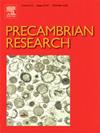Distinct mantle sources of two types of Neoproterozoic diabase in the North China Craton: Implications for mantle plume activity and ancient continent reconstruction
IF 3.2
2区 地球科学
Q2 GEOSCIENCES, MULTIDISCIPLINARY
引用次数: 0
Abstract
Large igneous provinces (LIPs) are often used as powerful tools for constraining continental reconstructions. The configuration of the North China Craton (NCC) in the Rodinia supercontinent remains a subject of controversy due to limited reliable records of Neoproterozoic magmatism. In this study, two types of Neoproterozoic mafic magmatic rocks, known as the Langan diabase (∼913 Ma), have been identified in the southeastern margin of the NCC: (1) Group Ⅰ that exhibits low La/Yb ratios (3.8–6.4), ∑REE contents (51–74 ppm), εNd(t) (-6.9 – -0.3), εHf(t) (1.98–6.26) and relatively high 87Sr/86Sr(i) (0.705047 to 0.706353), Mg# (58–63) and δ18O values (6.65–7.82‰); (2) Group Ⅱ-1 that has high ∑REE contents (214–222 ppm), εNd(t) (2.3–4.1), εHf(t) (5.03–10.70), and low 87Sr/86Sr(i) (0.704479–0.704829), Mg# (~33), La/Yb ratios (6.1–6.3) and δ18O values (6.36–7.20‰). Meanwhile, Group Ⅱ-2 mafic rocks can be identified in previous studies that differ from the Group Ⅱ-1 samples in having much higher La/Yb ratios (8.0–19.0). The geochemical differences between Group Ⅰ and Group Ⅱ mafic rocks indicate that they might have originated from distinct mantle sources under varying melting conditions and undergone different differentiation and contamination processes. In the shallow magma chamber, Group Ⅰ samples underwent a process of fractionation involving olivine and clinopyroxene, whereas Group Ⅱ samples exhibited fractional crystallization encompassing olivine, clinopyroxene, plagioclase, and rutile. According to REE inversion calculations, the primary magma of Group Ⅰ samples were derived from the high degrees of partial melting (5–20 %) of a spinel-dominant peridotite mantle source, and the Sr-Nd-O-Hf isotope composition indicates that there are approximately 30 % continental lithospheric mantle components in their mantle source. In contrast, the Group Ⅱ-1 diabase’ parental magmas were generated by 5–20 % partial melting of a garnet-bearing pyroxenite mantle source, while the Group Ⅱ-2 samples were derived from low degrees of partial melting (3–10 %) of a garnet-dominant pyroxenite mantle. All Group Ⅱ sample mantle sources contain approximately 20 % lithospheric components.
Combining all Neoproterozoic mafic samples in the São Francisco Craton and the Congo Craton, this research pointed out that these rocks might have resulted from a mantle plume. In detail, at the beginning of mantle plume activity, the primary magma of Group Ⅱ-1 sample was derived from the mixing between the mantle plume margin and a small amount of overlying lithospheric mantle in the spinel-garnet transition zone. Shortly thereafter, in a brief span of time, the subsequent upwelling of high-temperature magma assimilated more lithospheric components in the plume’s axial area, producing the Group Ⅰ samples’ primary magma in the spinel stability field. Within the periphery of the mantle plume, the thicker lithospheric mantle confines melting activities to occur only in the garnet stability field, resulting in a relatively low degree of melting and producing the primary magma of Group Ⅱ-2 samples. Finally, based on the spatial chemical variation of all Neoproterozoic mafic magmas, a new model for reconstructing ancient continents has been proposed, which illustrated the NCC was adjacent to both the São Francisco and the Congo Craton, and the Xuhuai Basin, Pedro Lessa diabase, Espinhaço mafic rocks and Gangila meta-basalts could represent the mantle plume’s central position.
华北克拉通两种新元古代辉绿岩的不同地幔源:地幔柱活动和古大陆重建的意义
大火成岩省(lip)经常被用作约束大陆重建的有力工具。华北克拉通在罗丁尼亚超大陆的构造由于缺乏可靠的新元古代岩浆活动记录而一直存在争议。在北陆东南缘发现了两类新元古代基性岩浆岩,即朗干辉绿岩(~ 913 Ma):(1)Ⅰ组La/Yb比值低(3.8 ~ 6.4),∑REE含量(51 ~ 74 ppm), εNd(t) (-6.9 ~ -0.3), εHf(t) (1.98 ~ 6.26), 87Sr/86Sr(i) (0.705047 ~ 0.706353), Mg# (58 ~ 63), δ18O值(6.65 ~ 7.82‰)较高;(2)Ⅱ-1族∑REE含量高(214 ~ 222 ppm), εNd(t) (2.3 ~ 4.1), εHf(t) (5.03 ~ 10.70), 87Sr/86Sr(i) (0.704479 ~ 0.704829), Mg# (~33), La/Yb比值(6.1 ~ 6.3),δ18O值(6.36 ~ 7.20‰)低。同时,前人研究发现,Ⅱ-2组基性岩石与Ⅱ-1组样品的La/Yb比值(8.0 ~ 19.0)要高得多。Ⅰ组和Ⅱ组基性岩的地球化学差异表明,它们可能起源于不同熔融条件下的不同地幔源,并经历了不同的分化和污染过程。在浅层岩浆房中,Ⅰ组样品经历了橄榄石和斜辉石的分馏过程,而Ⅱ组样品则经历了橄榄石、斜辉石、斜长石和金红石的分馏结晶过程。根据稀土元素反演计算,Ⅰ组样品的原生岩浆来源于尖晶石为主的橄榄岩地幔源的高度部分熔融(5 - 20%),Sr-Nd-O-Hf同位素组成表明其地幔源中约有30%的大陆岩石圈地幔成分。相比之下,Ⅱ-1组辉绿岩母岩浆是由含石榴石辉石岩地幔源部分熔融(5 - 20%)产生的,而Ⅱ-2组辉绿岩样品则是由含石榴石辉石岩地幔源部分熔融(3 - 10%)产生的。所有组Ⅱ样品地幔源含有大约20%的岩石圈成分。结合弗朗西斯科克拉通和刚果克拉通的所有新元古代基性岩石样本,本研究指出这些岩石可能是地幔柱形成的。在地幔柱活动开始时,Ⅱ-1群样品的原生岩浆来源于地幔柱边缘与尖晶石-石榴石过渡带少量上覆岩石圈地幔的混合作用。此后不久,在很短的时间内,高温岩浆的上涌吸收了羽流轴向区域更多的岩石圈成分,产生了尖晶石稳定场中Ⅰ组样品的原生岩浆。在地幔柱外围,较厚的岩石圈地幔限制了熔融活动只发生在石榴石稳定场,导致熔融程度相对较低,并产生了Ⅱ-2群样品的原生岩浆。最后,根据所有新元古代基性岩浆的空间化学变化,提出了一种新的古大陆重建模式,表明北克拉通与 o Francisco克拉通和刚果克拉通相邻,徐淮盆地、Pedro Lessa辉绿岩、espinhao基性岩和Gangila变质玄武岩可以代表地幔柱的中心位置。
本文章由计算机程序翻译,如有差异,请以英文原文为准。
求助全文
约1分钟内获得全文
求助全文
来源期刊

Precambrian Research
地学-地球科学综合
CiteScore
7.20
自引率
28.90%
发文量
325
审稿时长
12 months
期刊介绍:
Precambrian Research publishes studies on all aspects of the early stages of the composition, structure and evolution of the Earth and its planetary neighbours. With a focus on process-oriented and comparative studies, it covers, but is not restricted to, subjects such as:
(1) Chemical, biological, biochemical and cosmochemical evolution; the origin of life; the evolution of the oceans and atmosphere; the early fossil record; palaeobiology;
(2) Geochronology and isotope and elemental geochemistry;
(3) Precambrian mineral deposits;
(4) Geophysical aspects of the early Earth and Precambrian terrains;
(5) Nature, formation and evolution of the Precambrian lithosphere and mantle including magmatic, depositional, metamorphic and tectonic processes.
In addition, the editors particularly welcome integrated process-oriented studies that involve a combination of the above fields and comparative studies that demonstrate the effect of Precambrian evolution on Phanerozoic earth system processes.
Regional and localised studies of Precambrian phenomena are considered appropriate only when the detail and quality allow illustration of a wider process, or when significant gaps in basic knowledge of a particular area can be filled.
 求助内容:
求助内容: 应助结果提醒方式:
应助结果提醒方式:


